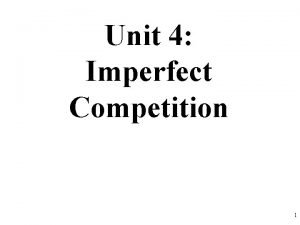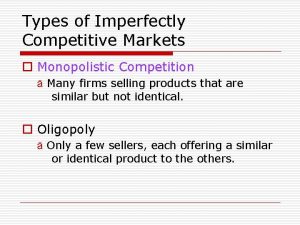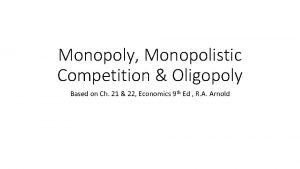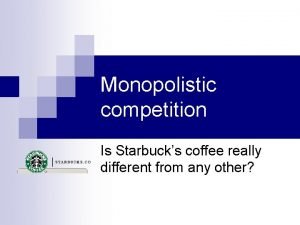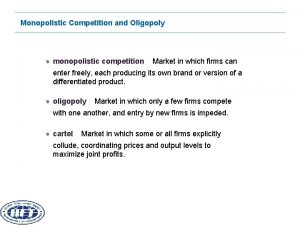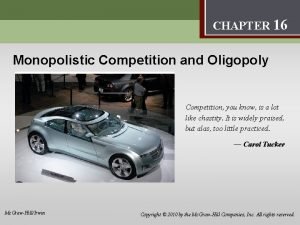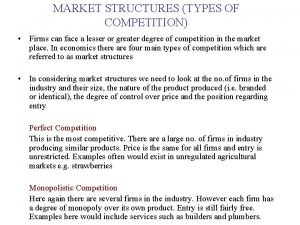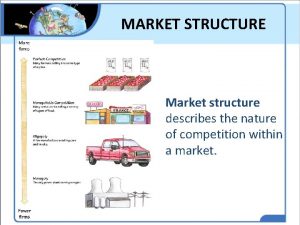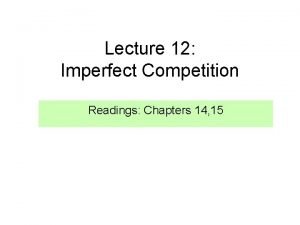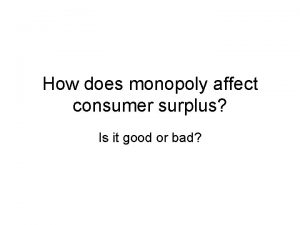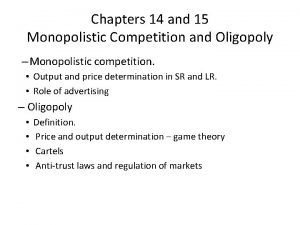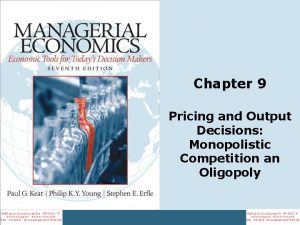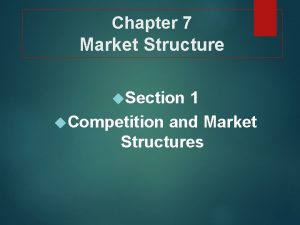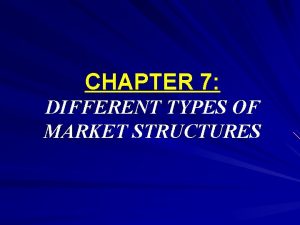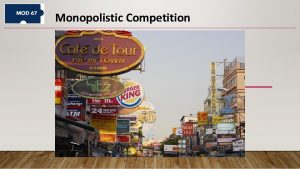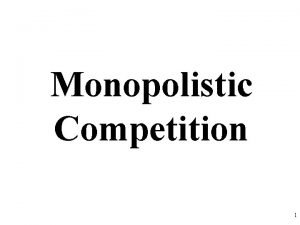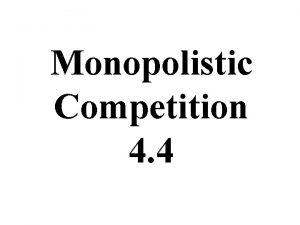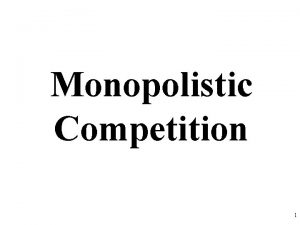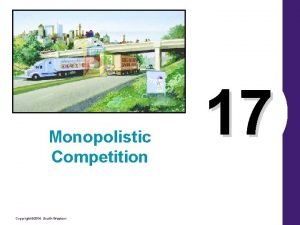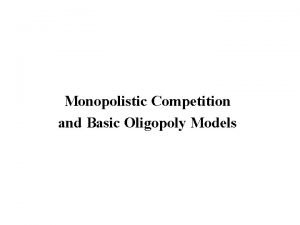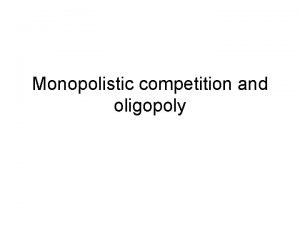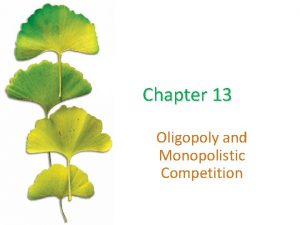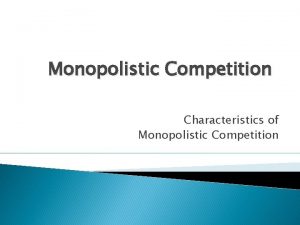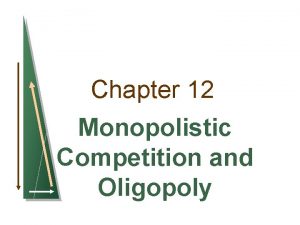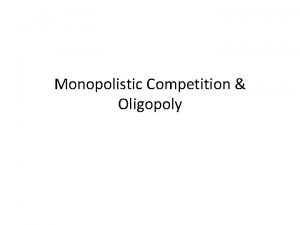Monopolistic Competition in Trade The DixitStiglitz Model Monopolistic















![Monopolistic Competition and Trade in a One-Sector Model [Krugman, JIE 1979] 2 countries; 1 Monopolistic Competition and Trade in a One-Sector Model [Krugman, JIE 1979] 2 countries; 1](https://slidetodoc.com/presentation_image/3050853c34c0a34cd7dd14eee1a98930/image-16.jpg)




![Heterogeneous Firm heterogeneity in monopolistic competition: [Melitz (Em 2003), Helpman-Melitz-Yeaple (AER 2004)] • Firms Heterogeneous Firm heterogeneity in monopolistic competition: [Melitz (Em 2003), Helpman-Melitz-Yeaple (AER 2004)] • Firms](https://slidetodoc.com/presentation_image/3050853c34c0a34cd7dd14eee1a98930/image-21.jpg)
- Slides: 21

Monopolistic Competition in Trade • The Dixit-Stiglitz Model • Monopolistic Competition and Trade in a One-Sector Model • Monopolistic Competition and Trade in a Two-Sector HO Model • Transport Costs and the Home-Market Effect • Economic Geography © J. P. Neary Saturday, October 31, 2020 1

Monopolistic Competition Due to Chamberlin; key features: 1. Differentiated products: reflecting a “taste for variety” – Hotelling approach (used by Helpman, JIE 1981): each consumer has an “ideal type” - difficult! – Dixit-Stiglitz “taste for variety” approach is now standard – Both approaches have identical implications for positive questions (but not for normative ones) 2. Increasing returns (due to fixed costs perhaps) – Otherwise, every conceivable variety could always be produced, in tiny amounts 3. Free Entry => No long-run profits – Just like perfect competition 4. No strategic behaviour: Firms ignore their interdependence when taking their decisions. 2

1. Tastes: Dixit-Stiglitz Utility Function • • • A symmetric CES function xi is the consumption of variety i n, the number of varieties, is given to consumers, but endogenous in equilibrium The index q is a measure of substitutability, and must lie in [0, 1] As we will show, it is related to the elasticity of substitution s : {0 <q < 1} <=> {1 < s < ¥} A. Preference for Variety/Diversity Proof: Assume all varieties have the same price p and are consumed in equal amounts, so total expenditure is I = npx (This is the indirect utility function in symmetric equilibria) Logarithmically differentiating, with I and p fixed: i. e. , utility rises with diversity, and by more so the lower is s QED 3

The indirect utility function can be inverted to get the expenditure function in symmetric equilibria: The unit expenditure function P is a true price index for the industry. It is decreasing in n (again, because consumers like variety) and to a greater extent the lower is s 4

B. Derive the Elasticity of Substitution Rewrite utility function as uq and differentiate w. r. t. pi: (from consumer’s FOC) Now, take ratio for goods i and j: {0<q<1} <=> {1<s<¥} C. Marshallian Demands Solve for xj, multiply by pj, sum over j and substitute into the budget constraint, S pjxj = I, to obtain: D. Industry Price Index Substitute into u(x) to get the indirect utility function V(p, I): So: 5

Finally, as in the symmetric case, this can be inverted to get the expenditure function: The demand functions can be expressed more simply in terms of the unit expenditure function P : (The Marshallian demand function is log-linear in relative price and real income, both defined with respect to P) 6

Production: Profit Maximisation by Firms maximise profits given the (perceived) demand curve (i. e. , they take income and the industry price index as given): Hence their total and marginal revenue curves are (suppressing i): So the demand MR curves are iso-elastic, with the latter a fraction q of the former. Costs Homotheticity: Production uses a composite input, at unit cost W Overheads require F units; and production c units per unit output: TC = (F+cx)W (Set W=1 for now) Hence: MC = c AC = c+F/x (a rectangular hyperbola) 7

Dixit-Stiglitz (symmetric CES) preferences: p -1/s ==> Demand: p = Ax Marginal Revenue: q p D MR x 8

Total Costs: C = F+cx p ==> Marginal Costs: c Average Costs: c+F/x AC c MC x 9

Profit Maximisation MC=MR => c = q p i. e. , p = c /q (p independent of A, F) Alternatively: p /c = 1/q = s /(s -1) (the price-cost margin is decreasing in s) Free Entry AC=AR => c + F/x = p + {MC=MR} => c + F/x = c / q => x = (s -1) F/c In equilibrium: i. e. , Equilibrium A is also independent of P, I, and therefore n 1

p Equilibrium: Chamberlinian Tangency • Profit maximisation: MR=MC • Free entry: p=0 ==> • Firm output depends only on F, c, s • Industry output adjusts to demand shocks via changes in n only c/q D c AC MC MR (s-1)F/c x 1

Technical Digression As drawn, the AC curve is more convex than the demand curve. Proof that this must be so: So, s > 1 is necessary and sufficient for AC to be more convex. 1

Equilibrium Firm Size In equilibrium, x depends only on c, F and s: all adjustment to changes in other exogenous variables is via changes in n How to avoid this implausible property? 1. Relax CES assumption. [Krugman, JIE 1979] 2. Assume more than one factor with non-homothetic costs: [Lawrence/Spiller, QJE 1983; Flam/Helpman, JIE 1987; Forslid/Ottaviano, JEG 2003] TC = rf + wax x = (s -1)rf/wa 3. Assume heterogeneous firms: [Melitz, Em 2003] xi = (s -1)Fi/ci 1

Role of s High s: • different varieties are close substitutes for each other (preference for diversity is not so strong) • p close to c : so p and MR curves are flat and close together • x large: economies of scale are highly exploited • fewer varieties, higher output of each Low s: • different varieties are less close substitutes (greater preference for diversity) • p >> c : so p and MR curves are steep and far apart • x small: economies of scale are not highly exploited • more varieties, lower output of each 1

p B A MR (low s) AC MR MC (high s) x Effects of Changes in the Elasticity of Substitution 1
![Monopolistic Competition and Trade in a OneSector Model Krugman JIE 1979 2 countries 1 Monopolistic Competition and Trade in a One-Sector Model [Krugman, JIE 1979] 2 countries; 1](https://slidetodoc.com/presentation_image/3050853c34c0a34cd7dd14eee1a98930/image-16.jpg)
Monopolistic Competition and Trade in a One-Sector Model [Krugman, JIE 1979] 2 countries; 1 sector; labour the only factor of production (W=w=1); identical technology and tastes in both countries. Full employment: L = n. Li = n(F+cx) => n = L /(F+cx) But: i. e. , number of varieties is linear in the size of the economy Autarky: L, L* => n. A , n. A*, x Trade: • All trade is intra-industry • Trade is unrelated to comparative advantage (Both countries have the same autarky prices, since they are identical except for size, which has no effect given identical homothetic tastes) • Trade is welfare improving (since it increases the number of varieties available) • Volume of trade is maximised when countries are of equal size 1

Monopolistic Competition and Trade in the Two-Sector Heckscher-Ohlin Model We extend the two-sector HO model by assuming that one sector has a Dixit-Stiglitz monopolistically competitive structure. 2 sectors: • X 1 “Food”: perfectly competitive, output homogeneous, p=1 • X 2 “Manufactures”: monopolistically competitive Tastes: An example of “two-stage budgeting”: • the utility function is Cobb-Douglas in food and manufacturing; • the manufacturing sub-utility function in turn has the Dixit-Stiglitz form. Expenditure function: 1

Economic Geography Standard features of Dixit-Stiglitz type models: 1. Demand intercept A depends: • positively on industry price index P • positively on expenditure I 2. Industry price index depends: • negatively on number of firms at home and abroad • positively on trade costs Additional feature of Venables model: Each firm uses the output of every other as an input. So: • Expenditure I depends positively on n • Input costs depend positively on P [Now we need to make W explicit: replace F and c by FW and c. W] Implications for stability of diversified equilibria: 1

p Effects of entry by one new firm: 1. P, P* fall => p fall 2. Cost linkage: P falls => W falls => p rise 3. Demand linkage: Demand rises => p rise 3 c. W/q 1 c. W D MR (s-1)F/c AC MC 2 x 1

l 1 Core Dispersal 0. 5 Periphery TB TS T Figure 2: Agglomerated and Dispersed Equilibria as a Function of Trade Costs 2
![Heterogeneous Firm heterogeneity in monopolistic competition Melitz Em 2003 HelpmanMelitzYeaple AER 2004 Firms Heterogeneous Firm heterogeneity in monopolistic competition: [Melitz (Em 2003), Helpman-Melitz-Yeaple (AER 2004)] • Firms](https://slidetodoc.com/presentation_image/3050853c34c0a34cd7dd14eee1a98930/image-21.jpg)
Heterogeneous Firm heterogeneity in monopolistic competition: [Melitz (Em 2003), Helpman-Melitz-Yeaple (AER 2004)] • Firms pay a sunk cost to reveal their productivity Draw c from g(c) with positive support over (0, ) • Given their productivity, they calculate their expected profits and choose to produce or exit Exit if c < ce where p(ce) = 0 or r(ce) = f. • If exporting and/or FDI require an additional fixed cost, only high-productivity firms will engage in them • Predictions are consistent with micro-empirical evidence 2
 Characteristics of a monopoly
Characteristics of a monopoly Perfect competition vs monopolistic competition
Perfect competition vs monopolistic competition Market structures venn diagram
Market structures venn diagram Perfect competition vs monopolistic competition
Perfect competition vs monopolistic competition Advantages of monopolistic competition
Advantages of monopolistic competition Excess capacity in monopolistic competition
Excess capacity in monopolistic competition Monopolistic competition characteristics
Monopolistic competition characteristics Price and output determination under monopoly
Price and output determination under monopoly Consumer surplus in monopolistic competition
Consumer surplus in monopolistic competition Monopolistic competition pictures
Monopolistic competition pictures Starbucks perfect competition
Starbucks perfect competition Monopolistic competition price
Monopolistic competition price Demand curve in oligopoly
Demand curve in oligopoly Fast food oligopoly or monopolistic competition
Fast food oligopoly or monopolistic competition Monopolistic competition in long run
Monopolistic competition in long run Market structure describes
Market structure describes Monopolistic competition short run
Monopolistic competition short run Consumer surplus in a monopoly
Consumer surplus in a monopoly Hhi monopolistic competition
Hhi monopolistic competition Example of pure competition
Example of pure competition Lesson quiz 7-1 market structures
Lesson quiz 7-1 market structures Monopolistic competition company examples
Monopolistic competition company examples




